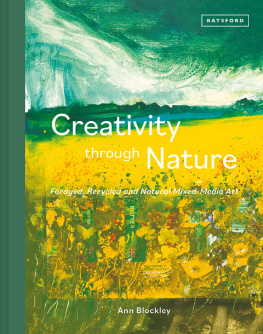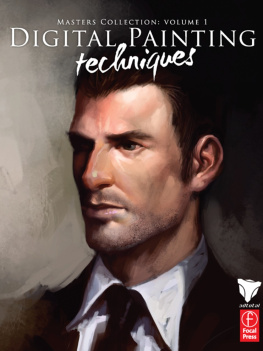Paint Lab
52 Exercises Inspired by Artists, Materials, Time, Place, and Method
Deborah Forman

2013 by Quarry Books
First published in the United States of America in 2013 by
Quarry Books, a member of
Quayside Publishing Group
100 Cummings Center
Suite 406-L
Beverly, Massachusetts 01915-6101
Telephone: (978) 282-9590
Fax: (978) 283-2742
www.quarrybooks.com
Visit www.Craftside.Typepad.com for a behind-the-scenes peek at our crafty world!
Visit www.QuarrySPOON.com and help us celebrate food and culture one spoonful at a time!
All rights reserved. No part of this book may be reproduced in any form without written permission of the copyright owners. All images in this book have been reproduced with the knowledge and prior consent of the artists concerned, and no responsibility is accepted by the producer, publisher, or printer for any infringement of copyright or otherwise, arising from the contents of this publication. Every effort has been made to ensure that credits accurately comply with information supplied. We apologize for any inaccuracies that may have occurred and will resolve inaccurate or missing information in a subsequent reprinting of the book.
10 9 8 7 6 5 4 3 2 1
Digital edition published in 2013
Digital Edition: 978-1-61058-947-5
Softcover Edition: 978-1-59253-782-2
Library of Congress Cataloging-in-Publication Data
Forman, Deborah.
Paint lab : 52 exercises inspired by artists, materials, time, place, and method / Deborah Forman.
pages cm
Summary: Paint Lab is packed with unique and experimental techniques and ideas in painting. This hands-on book is organized into 52 units, which may, but dont need to be explored on a weekly basis. The labs can be worked on in any order, so that you can flip around to learn a new mixed-media technique or be inspired by a particular painting theme or application. The underlying message of this book is that, as an artist, you should learn and gain expertise through experimentation and play. Paint Lab is illustrated with brilliant full-color images and multiple examples of each exercise. This book offers you a visual, non-linear approach to learning painting techniques, and reinforces a fun and fearless approach to creating art. Provided by publisher.
ISBN 978-1-59253-782-2 (pbk.)
1. Painting--Technique. I. Title.
ND1473.F67 2013
751--dc23
2013012479
Book layout: tabula rasa graphic design, www.trgraphicdesign.com
Series design: John Hall Design Group, www.johnhalldesign.com
All artwork by Deborah Forman, unless otherwise noted.
Developmental editor: Marla Stefanelli

For Nathaniel, with love
Contents
Introduction
I WAS WATCHING my five-year-old son the other day at the painting easel in our kitchen. I observed his enjoyment in the texture of the materials, and an uninhibited excitement about touching the paint to the surface of the paper. I imagine his inner dialogue went something like this: How can I make the tempera flow? What happens if I mix these colors? What happens if I use the brush like this, or make marks like this? Most likely, though, there was no dialogue at all, as he was truly spontaneous in his actions. There is a lot to learn from this. Painting harnesses the fun of play. Play is crucial to the creative process because a by-product of play is pleasure. I believe that the underlying principle of pleasure should always be present in the painting process. Play also brings you to the present moment. In this age of disconnect due to the prevalence of technology and screen time, painting can be an antidote as it connects you to your surroundings with the physical world.
Painting brings you to the present moment. Painting activates your physical sense of self. Painting helps you to feel alive and connected!
Many of the projects are based on experimenting with varying materials, surfaces, and concepts. Years ago I read an article about the work habits of well-known geniuses such as Picasso, Einstein, and Edison. A common trait among them was that they were ruthless in their risk taking and were not afraid of failure. They had a sort of what-if mentality in their endeavors, as they left no stone unturned in their quest of problem solving. Picasso filled stacks of sketchbooks before his masterpiece Guernica came to be. Einstein also had many notebooks filled with failed attempts at equations, and Edison had endless experiments that did not work. They were tenacious in their drive for discovery and did not let failure halt their attempts.
I truly believe that if you allow yourself to play you will unleash the painter that has been inside of you since you were that child at the easel years ago!
I hope this book will inspire you to play and take risks without the worry of what the outcome will be.
UNIT
Getting Started
IN THIS BOOK you will find a wide array of projects and exploration of materials. Many of the projects are idea based; therefore, your preference for paints and materials can easily be plugged into the lab. The labs are merely structures to define and enhance your space to play and experiment. If you find yourself missing a specific material, substitute something else! Enjoy the process. And dont worry about the outcome. This chapter reviews some of the basic materials you will be using.
Work Area
You can work anywhere that is comfortable for you. This can be on a tabletop or upright at an easel. Lighting is important, especially for perceiving color, so make sure you have a good amount of natural light, or install extra lighting as needed. Clip lamps are very helpful and can be purchased at the hardware store.
Substrates
Many of the exercises explore innovative surfaces to work upon, but basic supports for this book include prestretched canvas in a variety of sizes. Canvas boards are also great supports. Paper is also a wonderful surface to work on, and I recommend watercolor papers or any high-cotton-content rag paper. These come in a variety of weights, from 180 lb to thicker. Explore the paper department in your local art storeits fun! There are several online specialty art retailers, many of which are staffed with very knowledgeable personnel who can guide you in making selections.
Basic Materials
Here is a list of general supplies to get you started:
18" 24" (45.7 61 cm) heavyweight drawing pad
180 lb inexpensive watercolor paper sheets
9" 12" (23 30.5 cm) sketchbook
black construction paper
thin acetate sheets
prestretched and primed canvases (various sizes) or canvas boards
2b and hb pencils
white plastic eraser
glue sticks
pad of palette paper (small scale)
2 metal palette knives
scissors
18" (45.7 cm) ruler
craft knife with blades #1 and #11










